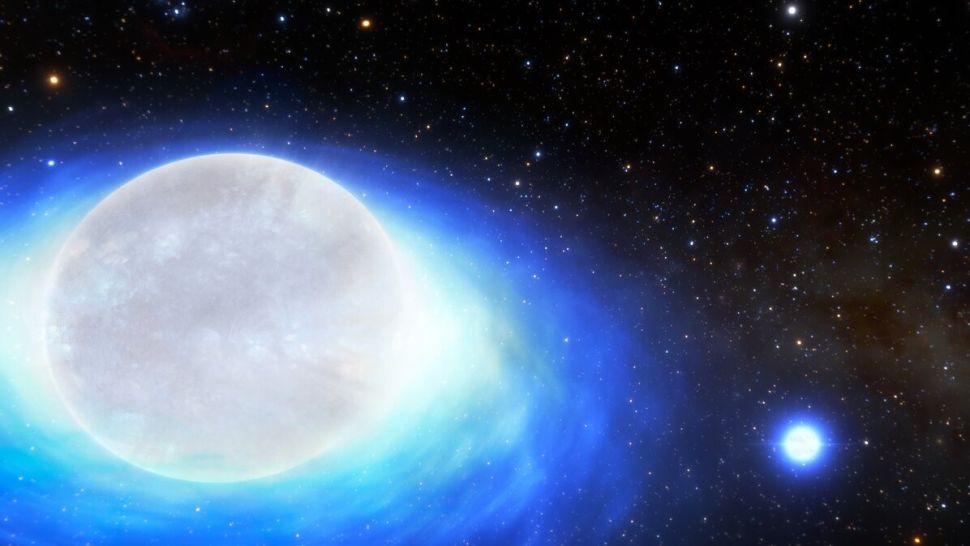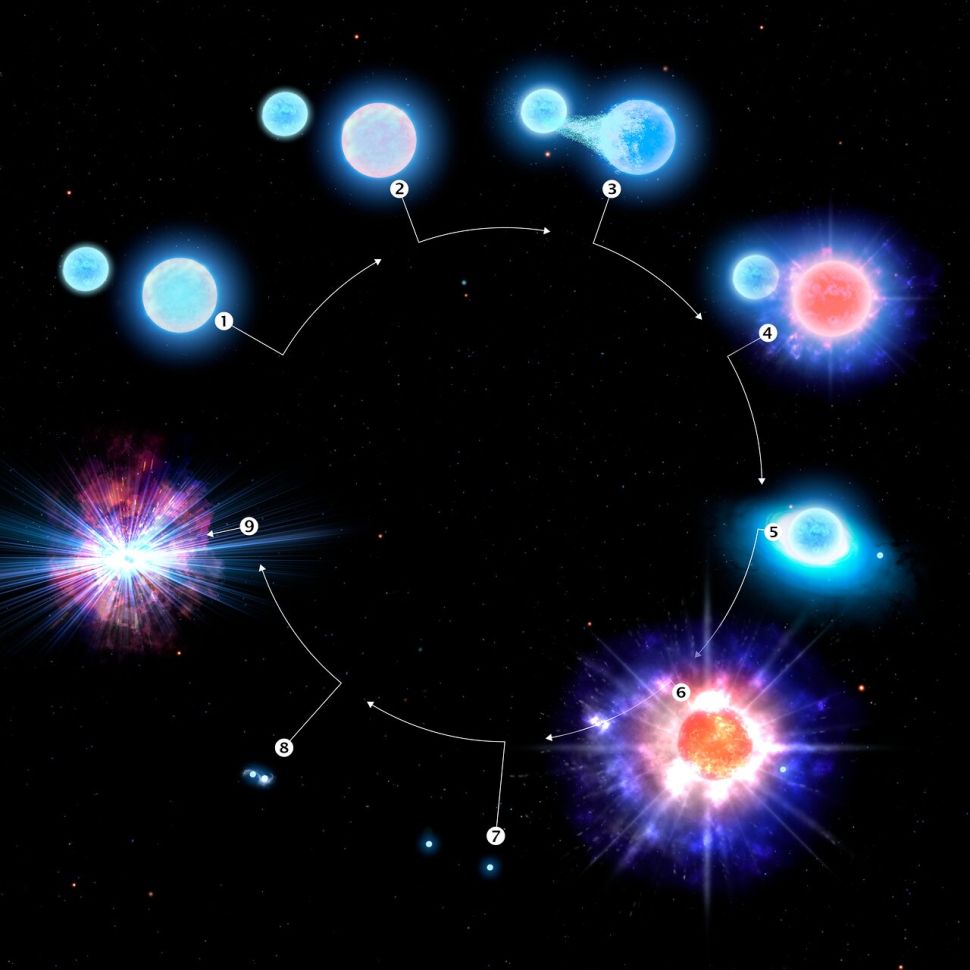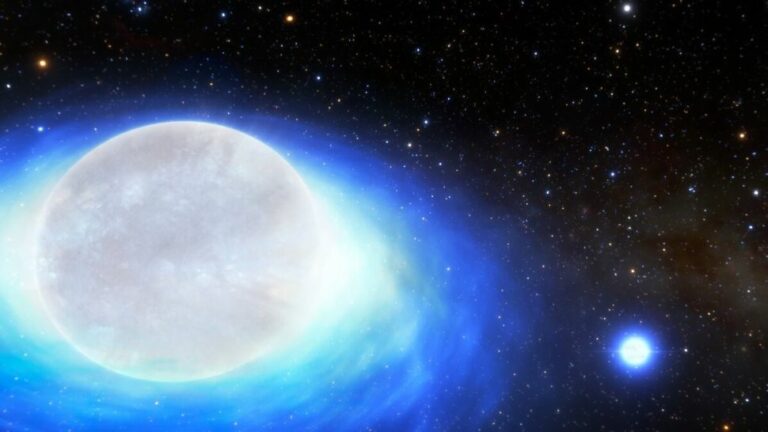Astronomers locate the first pair of twin stars that will collide in a kilonova explosion.
Although massive stars usually die with spectacular explosions, a handful fizzle out like dud firecrackers.
Astronomers have identified the remnants of one such dud firecracker in SGR 0755-2933, a neutron star about 11,400 light-years from Earth in the southern constellation of Puppis. In new research, scientists say that earlier in its lifetime, this star transferred abnormally high amounts of mass to its binary companion — so much so that it was not left with enough material for an explosive death. Instead, it ended in a quiet “ultra-stripped” supernova, a rare cosmic event that leaves a super-dense remnant called a neutron star in its wake.
“This remarkable binary system is essentially a one-in-10-billion system,” André-Nicolas Chené, an astronomer at the National Science Foundation’s NOIRLab research center and a co-author of the new study, said in a statement.

The neutron star and its closely orbiting binary companion — a star that the researchers also predict will someday collapse to become a neutron star — mark the first clear example of a star system that will ultimately trigger a kilonova, a cosmic explosion during which two neutron stars merge.
Although a kilonova was first detected in 2017, astronomers then recorded only the aftermath of the event, thanks to observations of light and gravitational waves. The new research is the first time scientists have identified a binary star system that they know will end in a kilonova explosion.
Moreover, astronomers previously thought that only one or two such systems would exist in spiral galaxies like our Milky Way. Researchers of the latest study have now increased that estimate to 10, noting that these observations help them better understand the history, evolution and atypically calm deaths of stars in such systems.
“For quite some time, astronomers speculated about the exact conditions that could eventually lead to a kilonova,” Chené said in the statement. “These new results demonstrate that, in at least some cases, two sibling neutron stars can merge when one of them was created without a classical supernova explosion.”
The sibling star is massive, orbits the primary neutron star every 60 days, and has a name like a license plate: CPD-29 2176. Scientists behind the latest research studied this sibling star to understand the formation of the current star system, as well as what might unfold in its future.
“This is not just a simple binary system”
Clarissa Pavao, an undergraduate student at the Embry-Riddle Aeronautical University in Arizona, found the system while scouring data captured by the Cerro Tololo Inter-American Observatory in Chile. In particular, she was plotting the spectra of the sibling star, an analysis of how much light a star emits at particular wavelengths. After cleaning noise from the data, she noticed one simple line in the spectra that suggested the massive star had a highly circular orbit — an unusual feature in binary star systems.
This was a key finding that helped the team conclude that the primary neutron star ended as a dud supernova, the astronomers said.
Usually, when one of the stars in a binary system burns through its hydrogen and nears the end of its main-sequence stage, it begins transferring mass to its companion star. The resulting end-of-life explosion often kicks companion stars out of the systems and into highly elliptical orbits.

But this did not seem to have occurred in the intriguing system. To better understand what might have happened at the end of SGR 0755-2933’s life, astronomers waded through thousands of models that described binary star systems resembling the one they were studying. They only found two that matched.
The team then traced the star’s history and concluded it behaved, for the most part, like any other massive star running out of fuel: Toward the end of its life, the star began transferring mass to its companion and dwindled into a low-mass star with a helium core, as scientists expected. In this process, however, the star lost so much mass that its end-of-life supernova “didn’t even have enough energy to kick the orbit into the more typical elliptical shape seen in similar binaries,” Noel Richardson, an astronomer at Embry-Riddle and lead author of the new study, said in a statement.
The dying star also did not have enough energy to kick its companion out of the system, which is why the two stars continue to have tight orbits, according to the study.
Marking the beginnings of precious heavy metals
In addition to learning more about kilonova events, the new research will help astronomers better understand the origins of some of the heaviest elements in our universe.
The quiet supernova occurred only a few million years ago, and astronomers expect the CPD-29 2176 system to remain as it is for at least one million years more. Their models show that, much like the primary neutron star, the sibling star too will then become an ultra-stripped supernova and eventually collapse into a neutron star.
Millions of years from now, the team predicts that the two neutron stars will spiral slowly toward each other in a cosmic dance, ultimately colliding in a kilonova explosion. Such explosions are known to be a source of immense quantities of heavy elements like platinum, xenon, uranium and gold “that get hurled into the universe,” Richardson said.
Astronomers have long suspected that heavy metals released during such events hovered in the interstellar medium until they coalesced into asteroids, which then bombarded Earth as it formed and deposited the precious metals we see today. The 2017 kilonova event alone sent at least 100 Earth’s worth of precious heavy metals out there, so it looks like a failed supernova isn’t such a loss to the universe after all.
The research is described in a paper published Wednesday (Feb. 1) in the journal Nature.
Source:SpaceCom
Do not forget to share your opinion with us to provide you with the best posts !




0 Comments